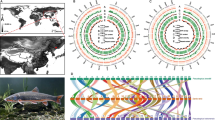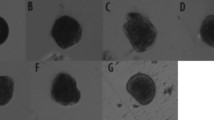Abstract
Ecological transitions from marine to freshwater environments have been important in the creation of diversity among fishes. Evolutionary changes associated with these transitions likely involve modifications of osmoregulatory function. In particular, relaxed selection on hypo-osmoregulation should strongly affect animals that transition into novel freshwater environments. We used populations of the Alewife (Alosa pseudoharengus) to study evolutionary shifts in hypo-osmoregulatory capacity and ion regulation associated with freshwater transitions. Alewives are ancestrally anadromous, but multiple populations in Connecticut have been independently restricted to freshwater lakes; these landlocked populations complete their entire life cycle in freshwater. Juvenile landlocked and anadromous Alewives were exposed to three salinities (1, 20 and 30 ppt) in small enclosures within the lake. We detected strong differentiation between life history forms: landlocked Alewives exhibited reduced seawater tolerance and hypo-osmoregulatory performance compared to anadromous Alewives. Furthermore, gill Na+/K+-ATPase activity and transcription of genes for seawater osmoregulation (NKCC—Na+/K+/2Cl− cotransporter and CFTR—cystic fibrosis transmembrane conductance regulator) exhibited reduced responsiveness to seawater challenge. Our study demonstrates that adaptations of marine-derived species to completely freshwater life cycles involve partial loss of seawater osmoregulatory performance mediated through changes to ion regulation in the gill.





Similar content being viewed by others
References
Able KW, Palmer AR (1988) Salinity effects on fertilization success and larval mortality of Fundulus heteroclitus. Copeia 1988(2):345–350
Barbour SE, Garside ET (1983) Some physiological distinctions between freshwater and diadromous forms of Atlantic salmon, Salmo salar. Can J Fish Aquat Sci 61:1165–1170
Bell MA, Foster SA (1994) The evolutionary biology of the threespine stickleback. Oxford University Press, Oxford
Berdan EL, Fuller RC (2012) Interspecific divergence of ionoregulatory physiology in killifish: insight into adaptation and speciation. J Zool 287:283–291
Birt TP, Green JM (1986) Parr-smolt transformation in sexually mature male anadromous and nonanadromous Atlantic salmon, Salmo salar. Can J Fish Aquat Sci 43:680–686
Burton MP, Idler DR (1984) Can Newfoundland landlocked salmon, Salmo salar, adapt to seawater? J Fish Biol 24:59–64
Christensen AS, Hiroi J, Schultz ET, McCormick SD (2012) Branchial ionocyte organization and ion-transport protein expression in juvenile alewives acclimated to freshwater or seawater. J Exp Biol 215:642–652
Conover DO, Schultz ET (1995) Phenotypic similarity and the evolutionary significance of countergradient variation. Trends Ecol Evol 10:248–252
Crespi BJ, Fulton MJ (2004) Molecular systematics of Salmonidae: combined nuclear data yields a robust phylogeny. Mol Phylogenet Evol 31:658–679
DeFaveri J, Merila J (2014) Local adaptation to salinity in the three-spined stickleback? J Evol Biol 27(2):290–302
DeFaveri J, Shikano T, Shimada Y, Goto A, Merila J (2011) Global analysis of genes involved in freshwater adaptation in threespine sticklebacks (Gasterosteus aculeatus). Evolution 65:1800–1807
Evans TG (2010) Co-ordination of osmotic stress responses through osmosensing and signal transduction events in fishes. J Fish Biol 76:1903–1925
Evans DH, Piermarini PM, Choe KP (2005) The multifunctional fish gill: dominant site of gas exchange, osmoregulation, acid-base regulation, and excretion of nitrogenous waste. Physiol Rev 85:97–177
Foote CJ, Wood CC, Clarke WC, Blackburn J (1992) Circannual cycle of seawater adaptability in Oncorhynchus nerka: genetic differences between sympatric sockeye salmon and kokanee. Can J Fish Aquat Sci 49:99–109
Fuller RC (2008) A test for a trade-off in salinity tolerance in early life-history stages in Lucania goodei and L. parva. Copeia 2008:154–157
Gahagan BI, Gherard KE, Schultz ET (2010) Environmental and endogenous factors influencing emigration in juvenile anadromous alewives. Trans Am Fish Soc 139:1069–1082
Hwang P-P, Lee T-H (2007) New insights into fish ion regulation and mitochondrion-rich cells. Comp. Biochem. Phys A 148:479–497
Jones FC et al (2012) A genome-wide SNP genotyping array reveals patterns of global and repeated species-pair divergence in sticklebacks. Curr Biol 22:83–90
Lahti DC et al (2009) Relaxed selection in the wild. Trends Ecol Evol 24:487–496
Lee CE, Bell MA (1999) Causes and consequences of recent freshwater invasions by saltwater animals. Trends Ecol Evol 14:284–288
Lee CE, Remfert JL, Gelembiuk GW (2003) Evolution of physiological tolerance and performance during freshwater invasions. Integr Comp Biol 43:439–449
Lee CE, Remfert JL, Chang Y-M (2007) Response to selection and evolvability of invasive populations. Genetica 129:179–192
Lee CE, Kiergaard M, Gelembiuk GW, Eads BD, Posavi M (2011) Pumping ions: rapid parallel evolution of ion regulation following habitat invasions. Evolution 65:2229–2244
Li C, Orti G (2007) Molecular phylogeny of Clupeiformes (Actinopterygii) inferred from nuclear and mitochondrial DNA sequences. Mol Phylogenet Evol 44:386–398
Marshall WS, Grosell M (2006) Ion transport, osmoregulation, and acid-base balance. In: Evans DH, Claiborne JB (eds) The physiology of fishes, 3rd edn. CRC Taylor and Francis, Boca Raton, pp 177–230
McCairns RJS, Bernatchez L (2010) Adaptive divergence between freshwater and marine sticklebacks: insights into the role of phenotypic plasticity from and integrated analysis of candidate gene expression. Evolution 64:1029–1047
McCormick SD (1993) Methods of nonlethal gill biopsy and measurement of Na+ , K+ -ATPase activity. Can J Fish Aquat Sci 50:656–658
McCormick SD (2013) Smolt physiology and endocrinology. In: McCormick SD, Farrell AP, Brauner CJ (eds) Fish physiology, vol 32. Academic Press, Waltham, MA, USA
McCormick SD, Saunders RL (1987) Preparatory physiological adaptations for marine life of salmonids: osmoregulation, growth, and metabolism. In: Dadswell MJ, Klauda RJ, Moffitt CM, Saunders RL, Rulifson RA, Cooper JE (eds) Common strategies of anadromous and catadromous fishes. American Fisheries Society, Bethesda, pp 223–229
McCormick SD, Shrimpton JM, Zydlewski JD (1997) Temperature effects on osmoregulatory physiology of juvenile anadromous fish. In: Wood CM, McDonald DG (eds) Global Warming: Implications for Freshwater and Marine Fish. Society of Experimental Biology Seminar Series 61
Nelson JS (2006) Fishes of the world. Wiley, New York
Nilsen TO, Ebbesson LOE, Madsen SS, McCormick SD, Andersson S, Bjoernsson BT, Prunet P, Stefansson SO (2007) Differential expression of gill Na+, K+-ATPase α- and β-subunits, Na+, K+, 2Cl− cotransporter and CFTR anion channel in juvenile anadromous and landlocked Atlantic salmon Salmo salar. J Exp Biol 210:2885–2896
Palkovacs EP, Dion KB, Post DM, Caccone A (2008) Independent evolutionary origins of landlocked alewife populations and rapid parallel evolution of phenotypic traits. Mol Ecol 17:582–597
Pfaffl MW (2001) A new mathematical model for relative quantification in real-time RT-PCR. Nucleic Acids Res 29:e45
Powers DA et al (1986) Genetic variation in Fundulus heteroclitus: geographic distribution. Am Zool 26:131–144
R Core Team (2012) R: A language and environment for statistical computing. R Foundation for Statistical Computing, Vienna, Austria. http://www.R-project.org
Schultz ET, McCormick SD (2013) Euryhalinity in an evolutionary context. In: McCormick SD, Farrell AP, Brauner CJ (eds) Fish physiology, vol 32. Academic Press, Waltham, MA, USA
Scott WB, Crossman EJ (1973) Freshwater fishes of Canada. Bulletin of the Fisheries Research Board of Canada. 184:1–96
Scott GR, Schulte PM (2005) Intraspecific variation in gene expression after seawater transfer in gills of euryhaline killifish Fundulus heteroclitus. Comp Biochem Phys A 141:176–182
Scott GR, Rogers JT, Richards JG, Wood CM, Schulte PM (2004) Intraspecific divergence of ionoregulatory physiology in the euryhaline teleost Fundulus heterclitus: possible mechanisms of freshwater adaptation. J Exp Biol 207:3399–3410
Searle SR, Speed FM, Milliken GA (1980) Marginal means in the linear model: an alternative to least squares means. Am Statistician 34:216–221
Shimada Y, Shikano T, Merila J (2011) A high incidence of selection on physiologically important genes in the threespine stickleback, Gasterosteus aculeatus. Mol Biol Evol 28:181–193
Stanley JG, Colby PJ (1971) Effects of temperature on electrolyte balance and osmoregulation in the alewife (Alosa pseudoharengus) in fresh and sea water. Trans Am Fish Soc 100:624–638
Staurnes M, Sigholt T, Lysfjord G, Gulseth O (1992) Difference in the seawater tolerance of anadromous and landlocked populations of Arctic char (Salvelinus alpinus). Can J Fish Aquat Sci 49:443–447
Stearley RF (1992) Historical ecology of Salmoninae, with special reference to Oncorhynchus. In: Mayden RL (ed) Systematics, historical ecology, and North American Freshwater Fishes. Standford Press, Stanford
Venables WN, Ripley BD (1999) Modern applied statistics with s-plus. Springer-Verlag, New York
Whitehead A (2010) The evolutionary radiation of diverse osmotolerant physiologies in killifish (Fundulus sp.). Evolution 64:2070–2085
Whitehead A, Roach JL, Zhang S, Galvez F (2011) Genomic mechanisms of evolved physiological plasticity in killifish distributed along an environmental salinity gradient. PNAS 108:6193–6198
Whitehead A, Roach JL, Zhang S, Galvez F (2012) Salinity- and population-dependent genome regulatory response during osmotic acclimation in the killifish (Fundulus heteroclitus) gill. J Exp Biol 215:1293–1305
Wilson MVH, Li GQ (1999) Osteology and systematic position of the Eocene salmonid Eosalmo driftwoodensis Wilson from western North America. Zool J Linn Soc 125:279–311
Yako LA (1998) Community interactions influencing juvenile anadromous herring in freshwater: migration cues and predation. M.S. Thesis. Wildlife and Fisheries Biology. University of Massachusetts, Amherst, USA
Zydlewski J, McCormick SD (1997a) The loss of hyperosmoregulatory ability in migrating juvenile shad, Alosa sapidissima. Can J Fish Aquat Sci 54:2377–2387
Zydlewski J, McCormick SD (1997b) The ontogeny of salinity tolerance in the American shad, Alosa sapidissima. Can J Fish Aquat Sci 54:182–189
Acknowledgments
We thank Dr. David M. Post, Andrew Jones, and Megan Cruz for their help collecting juvenile Alewives. We thank Dr. Arne K. Christensen for assisting in gill tissue sample collection, and Michael O’Dea for assisting in sample collection and for running Na+/K+-ATPase activity assays. We also thank Emily Funk for assisting with real-time quantitative PCR assays. Many thanks to Carl Schlichting, Mark Urban, Brian G. Walker, Alejandro Rico-Guevara, Jeffrey Divino, and two anonymous reviewers for providing helpful comments on the manuscript. This study was funded by Connecticut Sea Grant, the University of Connecticut Center for Environmental Science and Engineering, the American Museum of Natural History Lerner Gray Fund, the University of Connecticut Department of Ecology and Evolutionary Biology, and Sigma Xi Grants-in-Aid of Research. The authors declare no conflicts of interest. Any use of trade, product, or firm names is for descriptive purposes only and does not imply endorsement by the U.S. Government.
Author information
Authors and Affiliations
Corresponding author
Additional information
Communicated by Steve Swearer.
Electronic supplementary material
Below is the link to the electronic supplementary material.
Rights and permissions
About this article
Cite this article
Velotta, J.P., McCormick, S.D., O’Neill, R.J. et al. Relaxed selection causes microevolution of seawater osmoregulation and gene expression in landlocked Alewives. Oecologia 175, 1081–1092 (2014). https://doi.org/10.1007/s00442-014-2961-3
Received:
Accepted:
Published:
Issue Date:
DOI: https://doi.org/10.1007/s00442-014-2961-3




